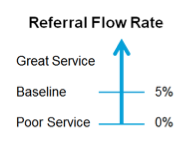Everyone knows that referrals/introductions are the number one driver of new business (our 2015 research confirms this once again). What’s evident, however, is that very few advisors quantify this properly. One of our favorite metrics to review is what we refer to as the Referral Flow Rate:

This is arguably the most important metric that nobody talks about. To be clear, when we say new households by referral, we mean new $250k+ households acquired by introduction or referral from current clients. This metric is a clear representation of your client service and referral/introduction process.
It’s a perfect time to ask yourself the following referral-related questions:
- What was your Referral Flow Rate last year?
- Has this increased or decreased over the past five years?
- How can you increase your referral flow?
If you’re looking for parameters on what constitutes a good Referral Flow Rate – 5% is a good starting point.
 Many advisors miss out on relatively simple fine tunings that can dramatically raise their referral flow. Take Bill for example – one of our long-time coaching clients. When we first met Bill, it was evident his referral flow was lacking. He’d received one referral that he could remember in the past year – on close to 200 households. Basically, only one of his 200 clients felt strongly enough about his services to refer him to someone else.
Many advisors miss out on relatively simple fine tunings that can dramatically raise their referral flow. Take Bill for example – one of our long-time coaching clients. When we first met Bill, it was evident his referral flow was lacking. He’d received one referral that he could remember in the past year – on close to 200 households. Basically, only one of his 200 clients felt strongly enough about his services to refer him to someone else.
We discussed plenty of options with him, but boiled down our strategy to three core elements – ramp up your non-business lunches, source names aggressively, and pay attention to the little things with your service offering. By little things, we mean custom labeled parking spaces, preferred beverages on arrival, remembering grandkids’ and pets’ names, sending thoughtful gifts, etc.
The results have been remarkable. This past year, four years into our coaching, his Referral Flow Rate is at 7.4% (13 new households on 175 clients). Want similar (or bigger) results? Follow this three-step action plan:
Step 1 – Measure your referral flow rate.
Count the new households you acquired by referral last year and divide this number by your total number of households. That’s your Referral Flow Rate. Much like with Bill, this number can be startling at first.
Step 2 – Work to increase your referral flow rate.
There are a number of factors that positively impact referral flow. If you study those with high referral rates (we do), you find they have a number of things in common:
- They are committed to getting personal with their affluent clients. Our studies show that broadening the relationship beyond business (getting personal) doubles the amount of referrals given. Bill’s strategy for one-on-one lunches works beautifully.
- When in conversation with their affluent clients, they’re on the hunt for names (without being obvious or pouncing). This gives them the ability to get specific when asking for introductions.
- They give clients ample opportunity to connect them. Whether it’s in a one-to-one setting or through an intimate event, those with high referral flow rates put their clients in referral-friendly situations.
- They have a track-record for doing what’s right for the client and delivering on all promises. Trust builds referral flow.
- They have clearly defined service models and deliver a service experience worth talking about (the buzz factor).
Step 3 – Monitor this on a quarterly basis.
Referral Flow Rate is an easy thing to calculate once, but it’s far more effective if done periodically. We’d recommend doing this on a quarterly basis. After the end of the next quarter, take a look at the number of referrals you’ve closed, multiply it times four, and then divide it by your total number of households. Hint – this number should be going up!
Stephen Boswell is a coach with The Oechsli Institute, a firm that specializes in research and training for the financial services industry. @StephenBoswell www.oechsli.com





